
Main Menu - Misc. - Clothing/Textiles - Medieval Wales - Names - Other Medieval - Publications - Harpy Publications
Return to main page
In order to understand the stylistic attributes that I'm identifying as the "Shepherds Purse", it's important to look at the range of purse or pouch types found in medieval and early modern art, whether used by shepherds or by others. In some cases, these styles may also be strongly associated with a particular social group or occupation. Although I obviously haven't studied that question in anywhere near the same detail as the Shepherds Purse, I've identified the types of associations I've found anecdotally.
A survey of 16th century purse styles can be seen in the following figures from Amman ("The Bag Maker"):

Here we see several styles of frame purses in the middle (the third from the left is a style commonly, but not at all exclusively, associated with hunters and falconers), and several complex drawstring purses at the right.
A style of purse that appears across a variety of social groups uses a rigid frame in the opening of the purse. (The purse may then close with a flap -- either soft or rigid -- or may extend beyond the frame and close with a drawstring.) One style hangs from the belt by a metal swivel mechanism, as in the painting of Abraham and Hagar.
The Portinari altarpiece shows two shepherds, but wearing alternate purse styles. What can be seen of this pouch is fascinating, although enough is hidden that the complete nature is unclear. The glint of metal at the top edge, as well as the general shape of the pouch, suggest a rigid frame of some type. Two or three metal rings are attached near the top edge, and various objects are attached to them. Most curiously, the musical horn is hooked onto the pouch-ring via a roughly-shaped double-hooked stick (see the larger b&w image on the catalog page for a clearer image). It is details like this that tend to lead me to conclude that a particular detail or artifact is being drawn from life -- such a fastening arrangement, though comprehensible, isn't the sort of thing an artist seems likely to invent (or to portray so clearly if working from a stock of fixed motifs).
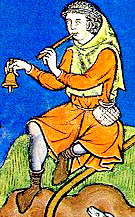
The pouch seen worn by David (as a shepherd) in the Maciejowski Bible may be either a loosened drawstring purse, or some early type of frame purse. Its position relative to the belt -- if accurate -- suggests some sort of loop on the back for carrying, but I'm not inclined to put too much interpretation into it.
A set of contrasts between shepherds wearing varieties of the Shepherds Purse, and huntsmen or falconers wearing some type of frame purse can be seen in several of the "pastoral" tapestries (although I don't include clips here): Rustic Sports, scene of hunting and dance, scene of hunting and shepherding #1, Return from the hunt. These clearly show the association of pouch style and occupation (whether purely iconographic or reflective of real life) as the members of both occupations are also clearly identified by other motifs.
Another style that has strong, but not exclusive, associations with a particular occupation is a type of deep, rectangular shoulder-bag commonly associated with pilgrims and other travelers.

The Ottheinrichsbibel has an example of this style carried by a swineherd while out in the fields watching his pigs. While I have found examples of shepherds wearing bags similar to the "crescent" style over the shoulder, I haven't yet found examples of them with this more square style.
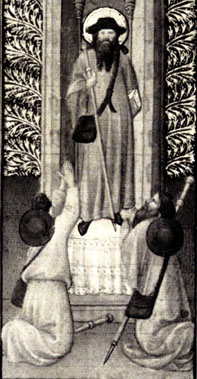

The Belles Heures show St. James the Greater wearing this style of pouch, strongly associated with the pilgrims who came to his shrine, as well as another scene of pilgrims in the context of the life of St. Catherine.
A similar shoulder-bag style in a more rounded shape has a somewhat regular association with shepherds, although nowhere near as commonly as the strict Shepherds Purse style (with which it overlaps in the Hours of Mary of England example below).
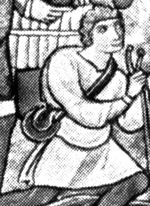
The Souvigny Bible has a fairly small pouch of this type, but the relative stylization makes the exact construction unclear.
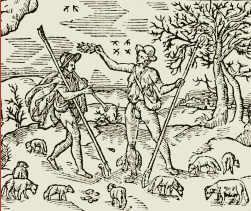
In an Elizabethan woodcut of two shepherds, the detail is very bad, but both wear a fairly deep shoulder bag with a flap covering the top.
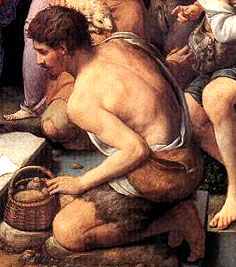
In the Bronzino adoration, we see a similar bag, but somewhat shallower, and more on the borderline with a crescent-shaped pouch simply worn over the shoulder.


Compare this with the two pouches seen in the Hours of Mary of England, where the forms are essentially identical, but one is worn over the shoulder and the other around the waist. Here the lesser depth of the shoulder pouch also moves it more into the realm of the Shepherds Purse.

Similarly, the shepherd's shoulder bag seen in the Virgin of the Stair has all the physical characteristics of a crescent-shaped Shepherds Purse, except for being worn over the shoulder.
A somewhat odd assortment of styles can be described roughly as composed of a tubular sack, one end of which is open but tied closed by a cord or strap that also forms a shoulder strap.
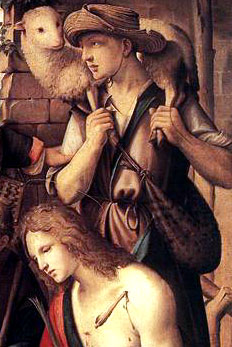
This example used by a shepherd in the Ghirlandaio adoration appears to be made of the skin of a spotted animal (the fur on the outside is clear in a close-up via the catalog page). At the front, one end is tied closed with a cord that goes over the shoulder to the back (and presumably ties onto the other end there). The combination of this whole-skin construction with the way the pouch hangs invites interpretation as a water-skin rather than a pouch in the ordinary sense.
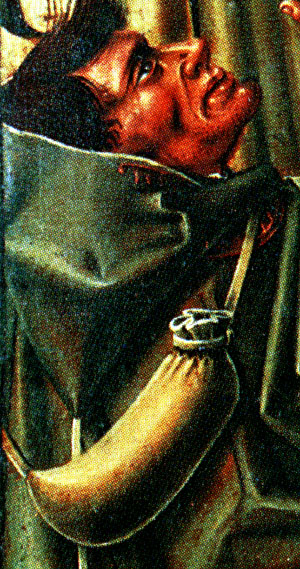
In the del Barco annunciation, a shepherd wears a pouch with a similar concept, but here the construction is clearer. A tubular bag has a leather strap attached to the closed end, which comes around to close the open end by means of a simple knot (I'd guess a half-hitch) -- common sense suggests the strap is also actually fastened to the bag at the open end, or the knot would seem likely to slip off. Again, if we interpret the shape and hang of the bag as realistic, this may be a waterbag rather than a pouch.

A shepherd in the Atri fresco wears a shoulder bag of unclear construction. While I'm hesitant to read too much into this fuzzy rendering, the apparent double-cord seen coming down to the bag across his chest suggests the possibility of a drawstring closing, although there are certainly other possible interpretations.
One of the most general styles of pouch found across a variety of social groups and occupations is a relatively small round or rectangular pouch with a flap that is attached to the belt either at the back of the pouch or hung by straps. The distinction from the Shepherds Purse style is seen most notably in the more discrete appearance: this is clearly a separate pouch attached to a belt, rather than a relatively extended pouch that, in essence, forms a separate "belt".
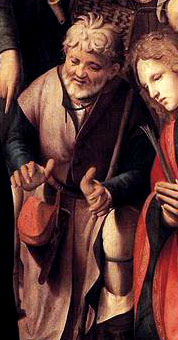
This example worn by a shepherd in the Ghirlandaio adoration is a typical example of the variant hung from the belt by straps, as are the following two examples.
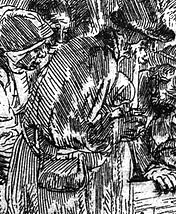

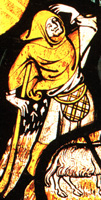
A rather curious pouch that doesn't really fit with the above examples is found in a stained glass annunciation. In common with the crescent-style Shepherds Purse, the pouch extends well around the waist (rather than being a separate discrete object), but it is much deeper than the Shepherds Purse (and occurs well before the time when that style is prevalent). The object is also shown with a hatch-mark pattern suggestive of netting, but the presence of the flap makes it clear that this is not a net bag. (This example is an excellent candidate for the use of iconic elements rather than realistic depiction.)
One relatively specific variant of this class of pouches has a characteristic "kidney" shape (i.e. a rounded, double-lobed outline). This style is most commonly associated with upper-class figures or with well-to-do craftsmen, and is often seen with a dagger thrust between the two belt-straps and behind the pouch. Several of these are seen worn by the carpenters at work on Noah's ark in the Bedford Hours, one of whom (at the right of the page) has a hammer thrust through the pouch in the same manner as a dagger.
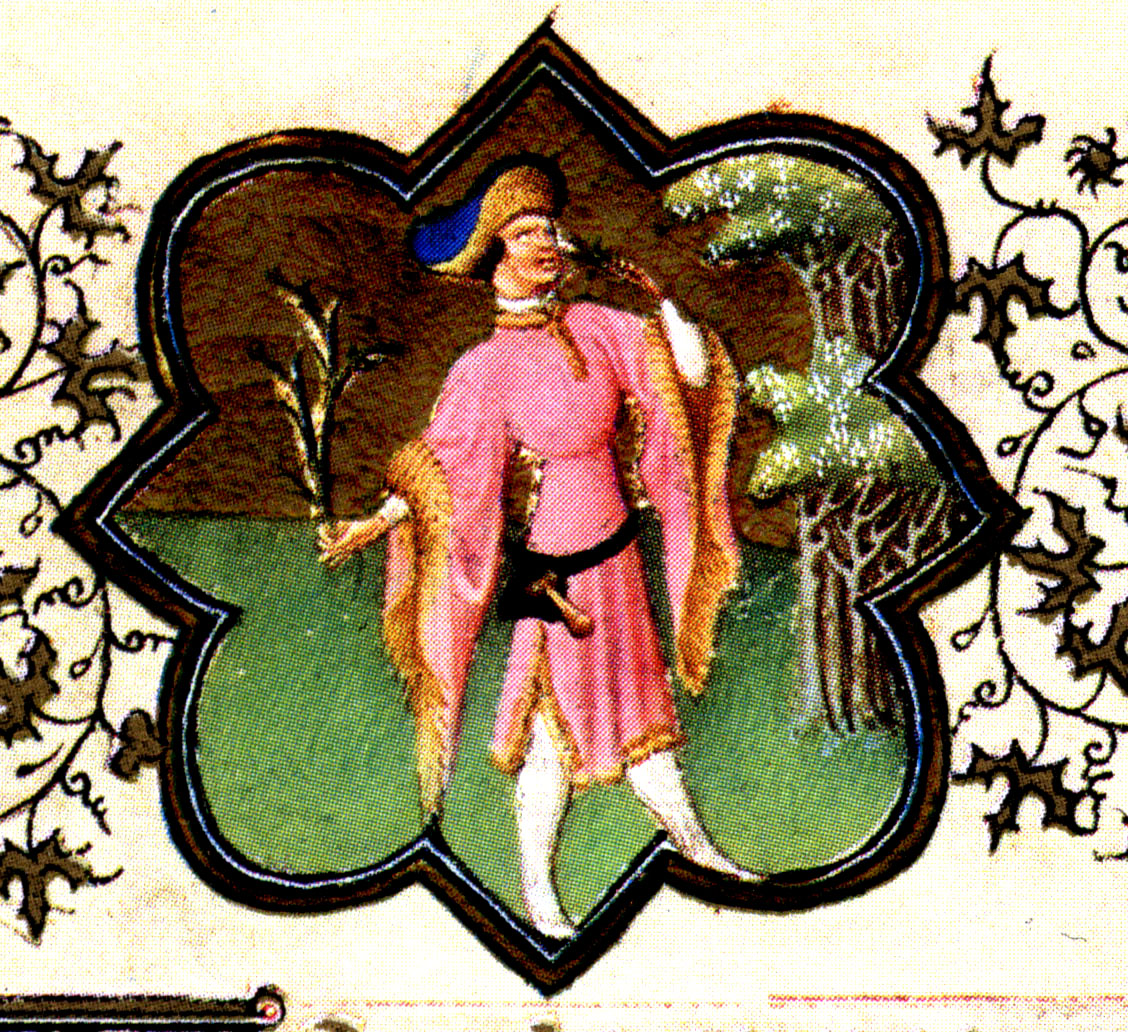
The Belles Heures (April) show the typical kidney-pouch & dagger set worn by a well-dressed man.

The Hours of the Maréchal de Boucicaut show this style of pouch worn by a shepherd in an Annunciation scene.

A slightly more elaborate version of the style is worn by a man in the Tapestry scene of hunting and shepherding #1. (The man is presumably a shepherd, indicated by the bagpipes he is playing.) The construction of the pouch looks interesting, but unfortunately my available picture does not have high enough resolution to make it out.
A variety of drawstring bags are found in various of the scenes. These may be attached closely to the belt as in the Portinari altarpiece below, but another very common style hangs them from a relatively long cord attached to the belt. In several scenes, this style is seen on women, where the purse hangs under the overgown (but can be seen because this gown has been kilted up), as in Bibl. Nat. Paris MS Lat 873 and Zodiacal Man.
The Portinari altarpiece shows two shepherds, but wearing alternate purse styles. Although this one is largely hidden in shadow, it is clearly a drawstring bag, possibly of leather, presumably attached to the belt, but by an unknown method.
This item doesn't really fit in with the group of unshaped cloth carrying devices, because it clearly involves some sewing. In form, it appears to be a long rectangular shape of two layers, sewn together around the edges, with an access hole of some type in the middle of its length. It is often seen sitting on the ground at the side of a field where reapers or mowers are working (usually in company with one or more costrels with drinkables). The other strong association is with travelers, and several examples are seen in association with Flight into Egypt genre scenes, or in the background of Nativity scenes (e.g., in the Atri frescos Nativity, where it hangs from a post of the stable on the right).

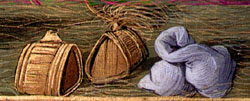


Given the association of this type of sack with reapers, it is possible that the white cloth laid across the lap of lunching reapers may be an empty version of this (but equally it could be an even simpler type of cloth carrying device).
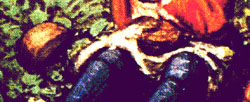
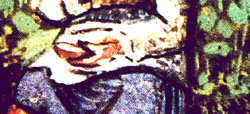

Two styles of carrier are clearly just a rectangle of cloth wrapped around the contents, and tied roughly either around the waist, or into something that can be slung over the shoulder.
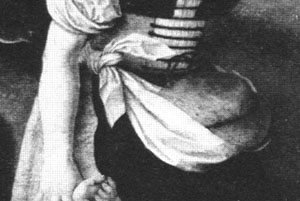
In the painting of Abraham & Hagar, we see what may be a technique that evolved into the sash style of Shepherds Purse.

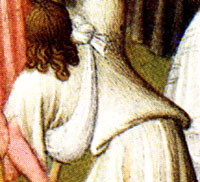
In two scenes in the Belles Heures, we see characters who appear to be beggars with a carrying sack over one shoulder formed from a simple cloth.
Previous --------------------------------------------- Main --------------------------------------------- Next
This site belongs to Heather Rose Jones. Contact me regarding anything beyond personal, individual use of this material.
Unless otherwise noted, all contents are copyright by Heather Rose Jones, all rights reserved.